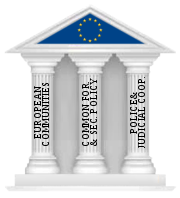European Communities
| European Communities | |
|---|---|
| Pillars of the European Union | |
|
|
|
| The three pillars which constituted the European Union (clickable) | |
|
|
|
| Constituent communities | |
| European Coal and Steel Community | 1952–2002 |
| European Economic Community | 1958–2009 |
| European Atomic Energy Community | 1958– |
The European Communities (EC), sometimes referred to as the European Community, were three international organisations that were governed by the same set of institutions. These were the European Coal and Steel Community (ECSC), the European Atomic Energy Community (EAEC or Euratom), and the European Economic Community (EEC); the latter of which was renamed the European Community (EC) in 1993 by the Maastricht Treaty, which formed the European Union.
When the Communities were incorporated into the European Union in 1993, they became its first pillar. The European Coal and Steel Community ceased to exist in 2002 when its founding treaty expired. The European Community was dissolved into the European Union by the Treaty of Lisbon in 2009; with the EU becoming the legal successor to the Community. Euratom remained an entity distinct from the EU, but is governed by the same institutions.
The ECSC was created first. Following its proposal in 1950 in the Schuman Declaration, Belgium, France, Italy, Luxembourg, the Netherlands, and West Germany came together to sign the Treaty of Paris in 1951 which established the Community. The success of this Community led to the desire to create more, but attempts at creating a European Defence Community and a European Political Community failed leading to a return to economic matters. In 1957, the EAEC and EEC were created by the Treaties of Rome. They were to share some of the institutions of the ECSC but have separate executive structures.
...
Wikipedia


